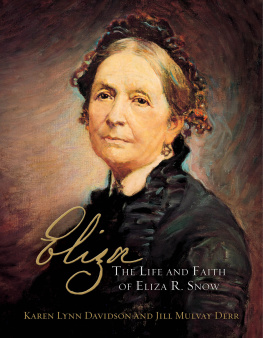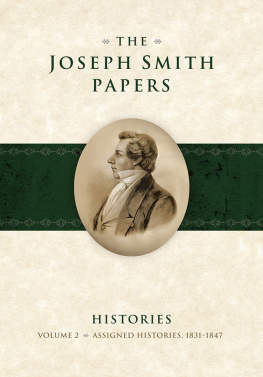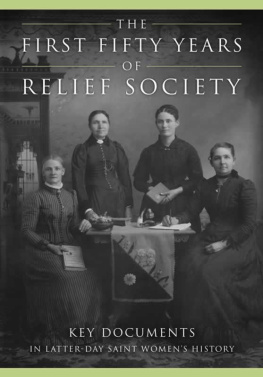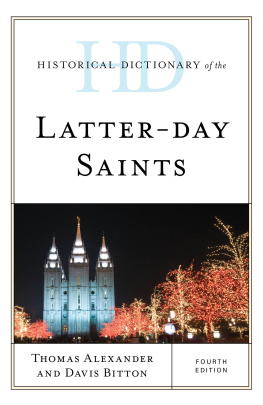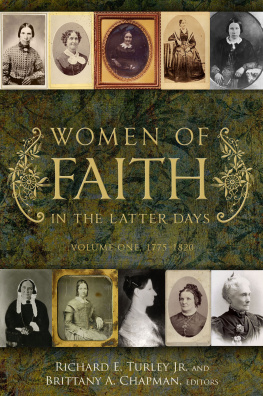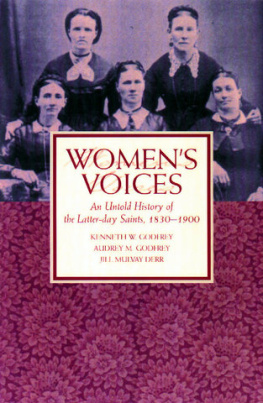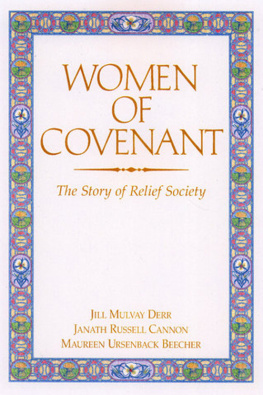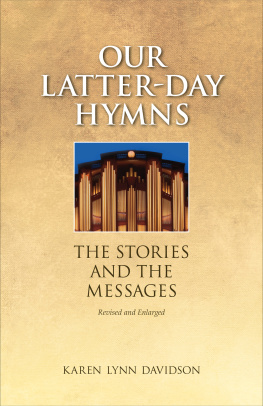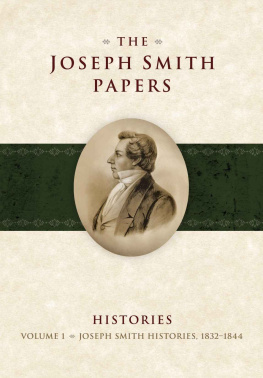2013 Karen Davidson, Jill Mulvay Derr.
All rights reserved. No part of this book may be reproduced in any form or by any means without permission in writing from the publisher, Deseret Book Company, P.O. Box 30178, Salt Lake City Utah 84130. This work is not an official publication of The Church of Jesus Christ of Latter-day Saints. The views expressed herein are the responsibility of the author and do not necessarily represent the position of the Church or of Deseret Book. Deseret Book is a registered trademark of Deseret Book Company.
Library of Congress Cataloging-in-Publication Data
Davidson, Karen Lynn, author.
Eliza: The Life and Faith of Eliza R. Snow / Karen Lynn Davidson and Jill Mulvay Derr.
pages cm
Includes bibliographical references and index.
ISBN 978-1-60908-902-3 (hardbound : alk. paper) 1. Snow, Eliza R. (Eliza Roxcy), 18041887. 2. Mormon womenBiography. 3. MormonsUnited StatesBiography. 4. Poets, American19th centuryBiography. I. Derr, Jill Mulvay, author. II. Title.
BX8695.S745D38 2013
289.3092dc23
[B]2012017495
Printed in the United States of America
R. R. Donnelley, Shenzhen, China
10 9 8 7 6 5 4 3 2 1

Photograph ca. 1875, by Charles W. Carter, courtesy Church History Library (CHL), The Church of Jesus Christ of Latter-day Saints, Salt Lake City, Utah.
Preface
What can Latter-day Saints draw from the life and writings of Eliza R. Snow? Certainly she is an icon of faith, one of the best known of all Mormon pioneer women. We hear her name often as an example of strength and devotion, and we sing her beloved hymns. When we ponder the precious Latter-day Saint teaching concerning a Mother in Heaven, we think immediately of O My Father. In photographs, with her serene expression and her far-seeing eyes that gaze at us across so many decades, Eliza Snow truly looks like the legend she has become.
Sometimes a legend can seem so distant in time, in circumstances so unlike our own, and the life so impossibly heroic, that we might wonder whether the woman behind the legend can really offer us anything to inspire and enrich our own lives. In fact, although the joys and sorrows of womens lives today may differ from those Eliza experienced, the responses and solutions remain largely the same. She spoke out boldly about her beliefs, and she reached out to others. When hardship came her way, she made the best of her circumstances; at a particularly difficult moment on the trail to Winter Quartersa growling, grumbling, devilish, sickly timeshe resolved to see the game thro, & enjoy the scenery.
Many women and men, in reading her poems, have felt that Eliza really knew what it is like to lose a loved one, or to rejoice in friendship, or to suffer under injustice, or to love ones country, or to overflow with testimony and gratitude. Such experiences are universal among Latter-day Saints, and Elizas writings let us know, poem by poem and journal entry by journal entry, that she would understand us nearly perfectly. For our part, we can understand her as well, especially as we come to know her better through her life story and her writings.
Like all those who have become legends, Eliza R. Snow was courageous, resourceful, dedicated, and persuasive. And to this list we add the additional traits that so endear her to us as a woman of God: her unflagging testimony of the Prophet Joseph Smith and of his prophetic successors, her willingness to sacrifice for the kingdom, her commitment to developing womens spiritual strength, her love for temples and temple work, and her ever-present vision of the destiny of the Saints as the Lords chosen people of the latter days. These values shine through Elizas poetry.
Many do not realize that the poetry of Eliza R. Snow is far more than the hymn texts we love. Among her more than five hundred poems are funeral tributes, reflections on home and family, rhymed sermons, nature poems, tributes to her many close friends, playful songs, and complicated epics. Sometimes a private emotion or impulse sparked the idea for a poem. At other times, she was called upon to be a spokeswoman on behalf of the Saints, and thus her words helped the early members of the Church, in times of success and in times of trial, to form their image of themselves and their mission.
Born on January 21, 1804, in Becket, Massachusetts, Eliza was the second daughter of fifth-generation New Englanders Oliver and Rosetta Pettibone Snow. When Eliza was almost two years old, the family moved to Mantua, Ohio, where Eliza was to live for almost three decades. The Snows were financially successful, civic-minded, and well respected. Oliver and Rosetta Snow taught all their childrenfive more were to be born into the familyto be responsible and hard-working, and they encouraged their daughters as well as their sons to read and become educated. Eliza worked as a secretary in the office of her father, who was a successful farmer and justice of the peace, and she was employed as a seamstress and schoolteacher as well.
Even as a schoolgirl, Eliza loved to read and write poetry. In 1825, when she was twenty-one, her first published poem appeared in the Ravenna, Ohio, Western Courier. Thus began a poetic career that was to continue for more than sixty years.
In the early months of 1831, the Snow familys friend and minister, Sidney Rigdon, introduced them to Joseph Smith. Soon thereafter Elizas sister Leonora and their mother, Rosetta, joined the Church, but Eliza and other family members held back. More than four years later, after much thought and study, the thirty-one-year-old Eliza entered the waters of baptism, and from that moment on she placed her poetic gifts at the service of the Church. She soon moved to nearby Kirtland, Ohio, to join with the Saints.
Once she had cast her lot with Joseph Smith and his followers, Eliza experienced the dangers and privations that marked so much of early Latter-day Saint history. Accustomed to comfort and security, she now faced uncertainty. In the spring of 1838, as neighboring Ohioans began to object to the Saints increasing political influence and as economic collapse faced Kirtland, she left Kirtland to settle with her family and her fellow Saints in northern Missouri. In 1839, the rising threats and persecution in Missouri left the Saints no choice but to flee the state, and the Snows joined the exodus to Illinois. There, on the banks of the Mississippi, the Saints founded the city of Nauvoo.
Under the direction of Joseph Smith, the industry of the Saints produced a large, well-ordered city with a beautiful temple under construction. There Elizas life changed significantly when, in June 1842, she was sealedmarried by priesthood authorityas a plural wife to the Prophet Joseph Smith. Within a few years, Joseph Smiths nontraditional teachings and the Saints melding of civic and religious authority antagonized neighbors and even some Church members. Once again, intense conflict threatened the safety and liberty of the Saints. Joseph Smith was murdered on June 27, 1844, and Eliza mourned the loss of the man she had loved as both prophet and husband. Eventually the Saints were forced to abandon their city, their homes, and their temple. They began their trek westward under the leadership of Brigham Young, to whom Eliza had been married as a plural wife in October 1844. After a short stay in Winter Quarters, she arrived in the Salt Lake Valley on October 2, 1847.

